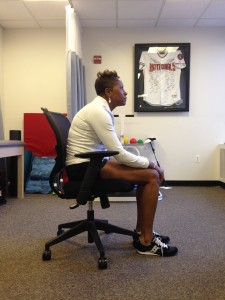
Prehabilitation (or “prehab”) refers to a therapy program designed either to prepare the body for surgery or as a method of injury prevention for athletic training, the work environment, or everyday functional activities. In this article, we first summarize prehab’s mental, emotional, and physical benefits for surgical clients based on recent research. Second, we discuss prehab as a way to reduce the likelihood of injury for sedentary as well as active lifestyles.
A proactive approach to surgery
Prehab can expedite your return to functional and recreational activities after surgery. Ditmyer et al. define prehab as “the process of enhancing the functional capacity of the individual to enable him or her to withstand the stressor of inactivity associated with an orthopaedic procedure. A generic prehabilitation program incorporates the components of warm-up, a cardiovascular component, resistance training, flexibility training, and practicing functional tasks.”(1) Simply stated, prehab involves training exercises to improve strength, stabilization, flexibility, range of motion, and balance to prepare the body for a prescribed surgical procedure.
Why rehab before surgery?
Mental and emotional preparation for surgery
Prehab will give you the opportunity to meet your physical therapist and develop a level of trust before surgery. Questions and concerns about the surgical procedure itself and post-surgical management can be addressed. In addition you will learn the appropriate exercises you will need to start immediately after surgery. For example, you might be taught how to ambulate on crutches or a walker should these devices be necessary post-surgery. You might also be instructed on how to negotiate stairs, curbs, and perform transitional movements correctly (e.g., getting in/out of a chair, bed, or car).
WOSM and SMARTherapy client Daniel Magraw states, “I enthusiastically recommend pre-surgery physical therapy. I had PT for several months before surgery to replace my right hip. I am 100 percent certain that this helped my post-surgery recovery. I was able to fly to London and Paris three weeks after my surgery, something I am sure I could not have done without the pre-surgery PT, which prepared me to go into surgery in relatively good shape. I imagine that it was also helpful psychologically, as it ensured I was doing something to keep myself healthy and prepare for recovery.”
Establishing muscle memory from prehab exercises will help recovery and restore more normal movement patterns following surgery.
Physical preparation for surgery
From a physical standpoint, research clearly supports prehab prior to surgery. A study by Eitzen and Moksnes “showed that a progressive rehabilitation program conducted within a mean time frame of 5 weeks, with emphasis on heavy resistance strength training and challenging neuromuscular exercises, led to significantly improved knee function in the early stage after ACL injury. It is, therefore, suggested to incorporate a short-term period of intensive exercise in ACL injury management, either before scheduled ACLR [ACL repair], or as a preparation for further non-operative management before returning to pre-injury activity without surgery”(2).
When someone suffers an acute ACL tear, it is imperative to decrease swelling to near normal, achieve full range of motion (especially full extension), and establish good quadriceps and hamstring strength prior to having surgery. Failure to achieve these goals could negatively affect outcomes. In another study, Eitzen and Holm found that preoperative quadriceps strength deficits negatively affect the outcome of an ACL repair if it is any more than 20% weaker than the uninjured knee prior to an ACL repair (3). It is believed that the stronger you are before surgery, the stronger you will be afterward, increasing the likelihood of a faster recovery. Establishing muscle memory from prehab exercises will help recovery and restore more normal movement patterns following surgery.
Prehab has also been found to help clients in need of a joint replacement. Snow et al. found that prehab for a joint replacement reduced the need for post surgical services by 29 percent (4).
These are just examples of the many studies finding that patients who participate in a moderate exercise program preoperatively have an accelerated recovery, for a wide range of orthopaedic surgeries. In prehab, your physical therapist will work closely with your physician to ensure you have an individualized plan prior to surgery. This will increase your chance for a fast recovery and a quick return to your prior level of function.
Training for work and sport
The concept of sport-specific training is well known with physicians and physical therapists. Prehab programs focus on preparing the body for the demands of a particular sport or activity.
The goal is to learn and perform strength and conditioning exercises for muscles used in your particular daily tasks or sport with a specific focus on reducing the likelihood of injury. This can range from postural exercises for those who sit at a desk all day to working on hamstring strength or jump landing techniques for basketball players to reduce the risk of an ACL tear. Another example would be shoulder strengthening for tennis or squash players, who often must deal with muscle imbalances.
Reducing the risk of injury
Neck and back pain
Neck or back pain can occur from poor postures, resulting in tight muscles in the front of the shoulder and hips, and weak muscles in the back of the shoulder, gluteals, and core. A prehab program would identify the weak or problem areas and address them through postural education, flexibility, strength, and stabilization exercises.

Poor posture can lead to neck and back pain.

Correct posture.
Shoulder pain
Shoulder tendonitis can occur from over-development of the anterior muscles of the shoulder and internal rotators, coupled with an under-development and subsequent weakness of the musculature in the back of the shoulder and external rotators. Again, a physical therapist would evaluate these areas and determine what strengthening and/or stretching exercises might be appropriate to re-establish muscle balance.
Knee pain
Anterior knee pain among athletic or active individuals is often caused by muscular imbalances as well which can lead to abnormal pressure on the front of the knee. The human body often finds a way of compensating for these imbalances, but this can lead to physiological problems and pain (e.g., patella femoral pain syndrome or PFPS). Common reasons for compensation and subsequent knee pain are gluteal weakness, adductor tightness, landing hard while running, and foot position as it hits the ground. The VMO is one of the muscles responsible for patella (knee cap) movement. This helps to keep it aligned and track smoothly over the femur (thigh bone) minimizing wear and tear behind the patella.
Iliotibial restrictions can also be a cause of knee pain. Iliotibial restrictions and inflammation causing knee pain can often be addressed with strengthening of the gluteals and stretching. It can be beneficial to have a PT assess the knee for gluteal weakness, VMO weaknesses, and running form to correct any of these impairments.
ACL sprains
The ACL injury typically occurs when there is a sudden stop, twist, pivot, or change in direction at the joint or extreme over-straightening (hyperextension). Research shows that the risk of injury can be decreased by having a good quad-to-hamstring strength ratio, jump/landing education, and plyometric training. All of these would be assessed and addressed in a physical therapy prehab program.
Conclusion
All in all, the goal of prehab is to reduce post-surgery recovery times and to aid in injury prevention for daily living, work, or sport. This concept is becoming a vital component for a healthy lifestyle and a proactive approach to recovery and injury prevention.
 Holly Kreisle has been a practicing physical therapist for over 15 years and has treated a diverse population of clients in Chicago, Maryland, and Washington, D.C. Holly received her Master of Science degree in Physical Therapy from Nova Southeastern University and a bachelor’s degree from Emory University, where she was member of the varsity basketball team. She has been a member of the SMARTherapy staff since 2009.
Holly Kreisle has been a practicing physical therapist for over 15 years and has treated a diverse population of clients in Chicago, Maryland, and Washington, D.C. Holly received her Master of Science degree in Physical Therapy from Nova Southeastern University and a bachelor’s degree from Emory University, where she was member of the varsity basketball team. She has been a member of the SMARTherapy staff since 2009.
 Michelle Black has been an orthopaedics and sports medicine professional since receiving her Bachelor of Science degree in Physical Therapy from Howard University in 1989. She has practiced in a wide variety of clinical environments and specializes in treatment of the shoulder, knee, and ankle. Michelle has been a SMARTherapy physical therapist at WOSM since 2009.
Michelle Black has been an orthopaedics and sports medicine professional since receiving her Bachelor of Science degree in Physical Therapy from Howard University in 1989. She has practiced in a wide variety of clinical environments and specializes in treatment of the shoulder, knee, and ankle. Michelle has been a SMARTherapy physical therapist at WOSM since 2009.
Want to know more?
For more information about prehabilitation, email us or request an appointment.
Be sure to follow us on Facebook and Twitter as well!
References
- Ditmyer, Topp, and Pfifer. (2002): n. pag. Web.
- Eitzen, and Moksnes. “A Progressive 5-Week Exercise Therapy Program Leads to Significant Improvement in Knee Function Early After Anterior Cruciate Ligament Injury.” N.p., n.d. Web.
- Eitzen, and Holm. “Preoperative Quadriceps Strength Is a Significant Predictor of Knee Function Two Years after Anterior Cruciate Ligament Reconstruction.” (n.d.): n. pag. Web.
- Snow, R., J. Granata, A. V. S. Ruhil, K. Vogel, M. Mcshane, and R. Wasielewski. “Associations Between Preoperative Physical Therapy and Post-Acute Care Utilization Patterns and Cost in Total Joint Replacement.” The Journal of Bone & Joint Surgery19 (2014): n. pag. Web.
